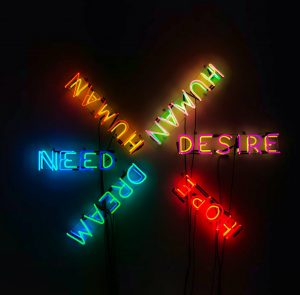Intentionality Deep Dive. Finish this sentence: I want . . .

Recognition + Intentionality –> Action + Impact
Simply put, recognition combined with intentionality leads to action and impact.
We wrote about recognition last time. This week we’re going to deep-dive into intentionality by exploring how recognition and intentionality interact.
Let’s start with a little exercise. Take out a piece of paper (or stand at a white board) and write down the following:
I want ________________.
Draw the line and the period, too.
Now, step back and consider what you really want, right now. It could be something big, like . . .
I want my spouse/friend/business partner to respect me more.
Or, it could be something small, like . . .
I want Chicken Pad Thai for lunch.
Don’t judge the size and nature of the desire, just go with what’s really true for you right now. Do you see what I wrote there? Go with what’s really true. Remember our definition of recognition from last week?
Recognition is the ability to see and identify things as they really are.
If that’s the case, then intentionality is focused attention on a desired outcome.
Or, at the risk of oversimplifying things, intentionality is answering, as an individual or organization, what do I really want?
It’s easy to see, then, how and why our model is written the way it is. It’s not:
Recognition OR Intentionality –> Action + Impact
Rather, it’s Recognition AND Intentionality . . .
Part of recognizing things as they really are is to account for what I want–what I really and truly want–whether that’s a desire for myself or a vision and desired direction for my organization, or both.
Recognition is not just about seeing what is needed. I need to eat something. I need to feel respected by those who are important to me. My business needs to cut spending or leverage greater efficiency. Yes, you may need all of those things.
What do you want?
Let’s take the Pad Thai example from above. You know that you need to eat lunch. That much you recognize. But, what you want to eat is as much a factor that leads to specific actions (and impacts) as recognition is.
Said in reverse, it makes no sense to decide what to eat for lunch by only considering your need to eat. Part of your decision necessarily involves what you want.
In fact, we’ve all been a part of a group of friends trying to decide on a place to go eat and being unable to decide because nobody is stating what they want. Everyone knows they need to eat, but no one is voicing what they want. It’s frustrating and a time-waster, and it often leads to a choice that no one is really happy with.
We can easily see the role of intentionality when it comes to deciding what to eat for lunch, but when it comes to the bigger questions in our lives and businesses, we often exclude what we want from the equation. We think that it’s important to make big life decisions objectively. Or, we think that decisions for our businesses should be made dispassionately, with the only the bottom line or the “big picture” in mind, whatever that means.
The truth is that recognition and intentionality go hand-in-hand when we have little decisions to make and when we have big life-changing or organization-changing decisions to make.
Fifty percent of you read that and thought, Great! I know exactly what I want and have no problem letting others know. The other fifty percent of you are still stuck on the I want _____________. exercise, above.
What do you do if you have difficulty identifying and voicing what you want? What do you do if you recognize needs but have difficulty saying what you want?
Are needs good and desires bad?
There a lot of reasons that some of us have difficulty knowing and stating what we want. It’s beyond the scope of this blog post to explore them all. Suffice it to say that many of us arrived at adulthood with the message, loud and clear, that considering needs is responsible and good, but stating what we want is selfish and bad.
And, of course, this is reasonable in the sense that reality sometimes dictates our course of action despite what we want. It doesn’t matter if we want to give our employees bonuses at the end of the year if we’re not in a financial position to do so.
But, there are times when our needs and desires are not in conflict and that the course of action we choose, for ourselves and our organizations, comes down to what we want. If we’re not used to knowing and stating our wants, if we think that doing so is selfish, what do we do?
Asking better questions.
One of the reasons people get stuck filling out I want ________. is that the question is so direct and pointed. If we do think that our wants are somehow selfish, the question What do you want? blunders right into that sensitivity.
Luckily, there are other questions that you can ask yourself that get to the same information. Here are a few that you can try:
1. What is most important to you right now?
This question addresses your values and pulls the spotlight off of what you want and puts it on the things that you find meaningful or worthy in this moment.
2. What is the outcome that you would like to see happen now or in the near future?
This asks you to use your imagination to envision a positive ending and what it would look like to make that positive ending a reality. It also provides some urgency by putting a soft deadline on the end of the question in the form of now or in the near future.
3. In this situation, what does success look like to you?
Similar to the last question, this requires that you use your imagination to describe success in a particular situation. It touches on our desire to be successful and, conversely, can properly and proportionately engage our fear of failure without swamping us in that fear.
4. If you can, can you identify why?
Each of the three questions above become richer and deeper when you can ask yourself why. As in asking yourself, What is most important to you, and, if you can, can you identify why? Asking yourself why, when asked considerately and with curiosity, invites you to consider what you want more deeply without triggering defensiveness or the need to justify your answers.
In summary
Recognition and intentionality go hand-in-hand. Seeing things as they really are and focused attention on a desired outcome are powerful and necessary ingredients to actions that have a real impact in our lives and in our organizations.
Sometimes, asking yourself the right kinds of questions isn’t enough to get you or your business where you want to go. Perhaps you’ve recognized a need to change and have the intentionality to do so. Maybe you’ve even taken certain actions that haven’t had the impact you expected. Syte can help. Reach out, and let’s start the conversation that could change everything.
Please note that this will be the last blog post of this decade! At Syte, we try to slow down during the last two weeks of the year to re-charge and to focus on family time. Our last post in this mini-series will explore action and impact, and it will land on our around the 3rd of January, 2020.
In the meantime, please have a very Merry Christmas and Happy New Year with your families, loved ones, friends, and colleagues.
Photo by Stéphan Valentin on Unsplash
ERP Readiness Self-Assessment
Is your organization ready for a new or upgraded ERP solution? Find out with this complimentary self-assessment.
Doing Business Better
You strive for excellence, believe in your people, and want to do things right the first time. And you know that you need help to get to the heart of your business challenges and make the best choices for the future of your privately held manufacturing and distribution company. That’s where we come in.
We help you focus and find exactly the right path to accelerated growth and sustainable success — from your people to your processes to your ERP software.


